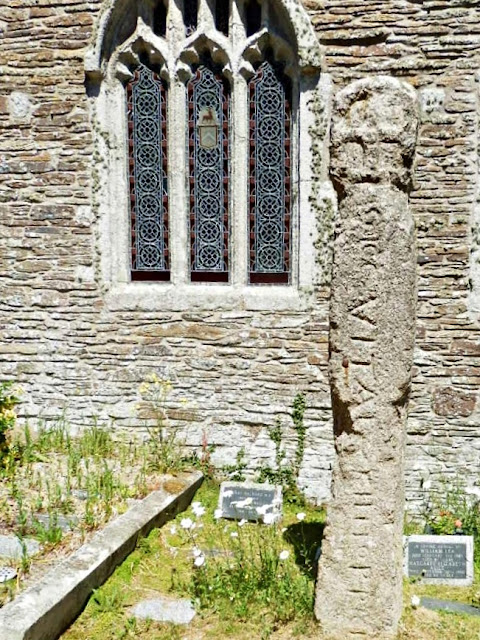It was a pleasant day so we decided to walk alongside the Tresillian River to the small village of St.Clement. The photo above shows some of the riverside cottages within the village.
The river is tidal and looked splendid in the sunshine. Unfortunately the tide was going out so there were mud flats in places.
The path by the river is a decent width.
No boats on the river, only those not being used.
When we arrive at St.Clement we always look out for the row of cups and mugs on one of the buildings.
The main attraction in the village is the 13th century church.
By the side of the church is a very old stone (below) known as the Ignioc Stone. There is an inscription 'VITALI FILI TORRICI' which translates as 'Vitalus son of Torricus'. It is thought that the stone goes back to the sixth or seventh century. There is another later inscription, IGNIOC - most probably a personal name - which gives the stone its name.
There are many old memorial stones, including the one below for William Callaway from 1784, as an example. It reads:
Today, of Health and strength we boast
To-morrow brings us down to Dust
May we, while Time & strength are giv'n
Believe in CHRIST & live for Heav'n
The church itself was closed, because of the coronavirus. After looking round the churchyard we wandered back to the river, where we munched on some sandwiches. Together with cups of tea, of course.
It was then time to start our return walk.
Lots of daisies on many of the stone walls.
The river looked nice despite the mud.
There's a small lake on the opposite side of the path. We managed to see a few small fish.
Lots of reeds by the river - and then we were back to our car, parked in a small lay-by.
Also see The Peaceful St.Clement Church by the Tresillian River, Cornwall. This has photos of the inside of the St. Clement church
















Oh to be in St Clement! I recall my first visit to what we called 'the Ogham stone' more than 40 years ago. We had discovered Men Scryfa near Men-an-Tol in Penwith and were keen to see what other kinds of stones there were with early scripts. I like William Callaway's epitaph. And what glorious daisies, Mike!
ReplyDeleteHello Caroline. We love to visit the old stones like the various quoits, the hurlers, Helman Tor, the Tristan stone and so on. All seem to have a touch of magic about them and links to another time.
DeleteI’ve never seen daisies growing straight out of a stone wall. That is delightful! You’ve captured well the sights along your walk and as always, the walk is steeped in interesting history. The river’s edge is much like any I would see here, thick and lush green. Tidal rivers make a great place to keep a small boat and it would be fun to have one just outside your cottage window! Lovely post all around!
ReplyDeleteThank you Ann. The daisies on the old walls make a lovely display, we see quite a few such displays on our walks. We never seem to get to the river at high tide, so have plenty of photos of mud! St. Clement itself is very small and peaceful.
DeleteThe river is really attractive, I often prefer a low tide. Very surprising to see all those daisies growing on the wall and some lovely colours, unusual. As are those cups, very strange. Your walks are always full of interest, this one had a few novel items. 😀
ReplyDeleteHello David, As for the cups, I think they are just for decoration, we always look at them, as one of the cops is the same as we often use at home. It's possible to continue walking alongside the river to Malpas and Truro. Thanks.
ReplyDelete